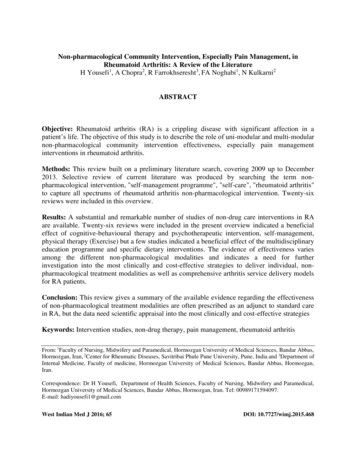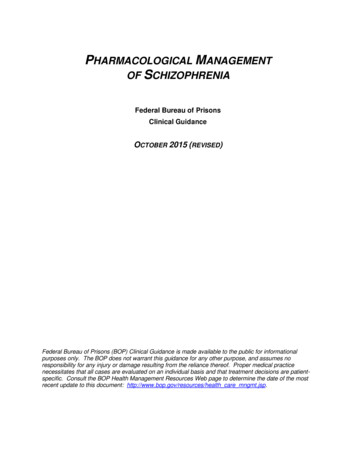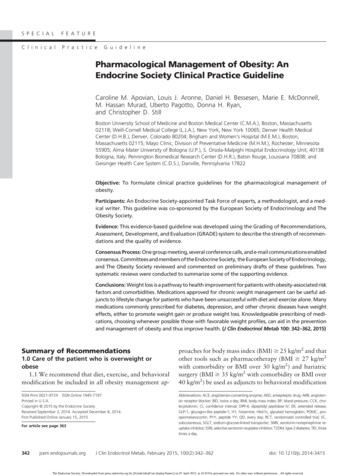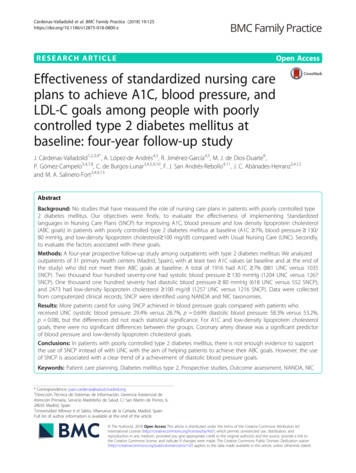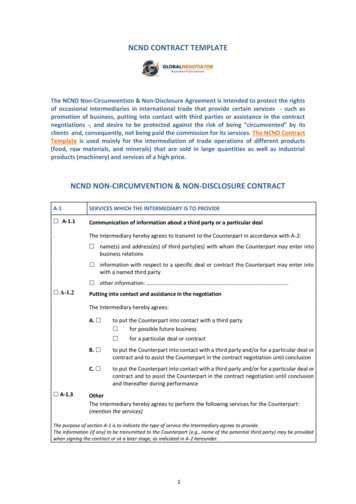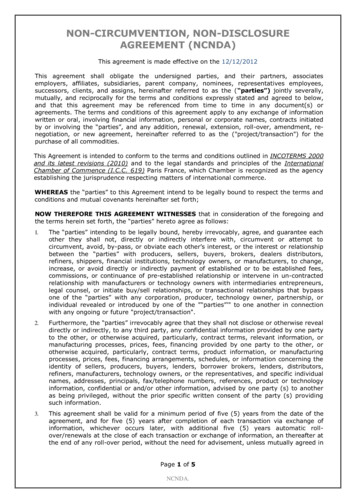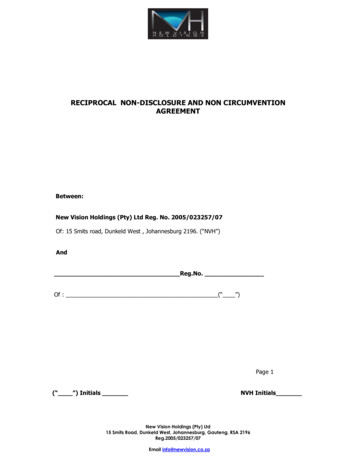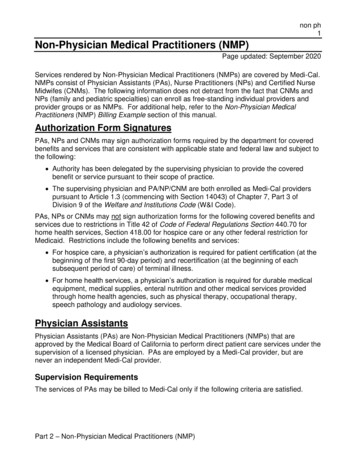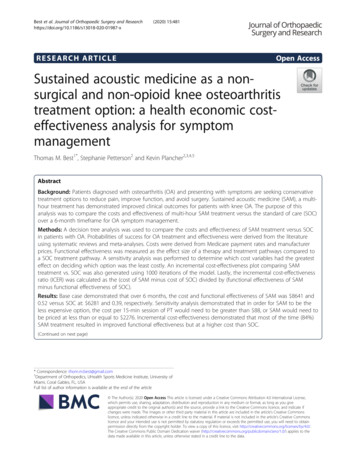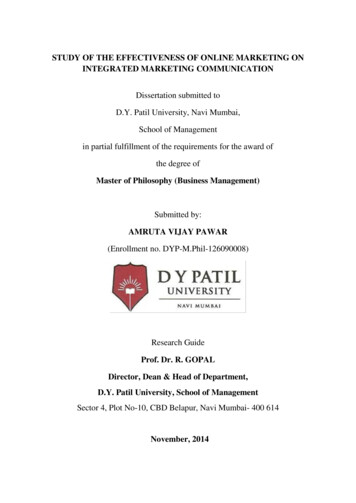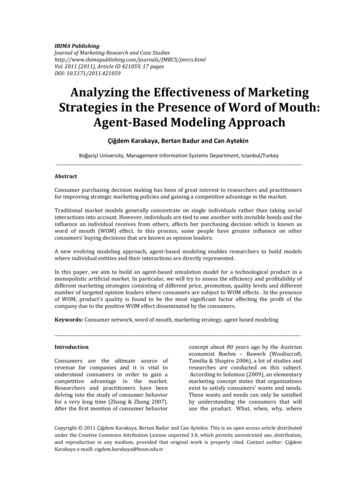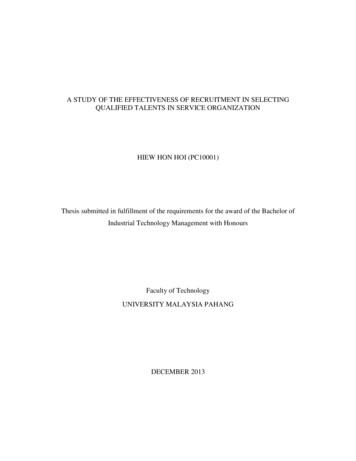
Transcription
Cent Eur J Nurs Midw 2017;8(3):682–690doi: 10.15452/CEJNM.2017.08.0019ORIGINAL PAPEREFFECTIVENESS OF NON-PHARMACOLOGICAL NURSING INTERVENTION PROGRAMON FEMALE PATIENTS WITH RHEUMATOID ARTHRITISEman Ali Metwaly1, Nadia Mohamed Taha1, Heba Abd El-Wahab Seliem2, Maha Desoky Sakr11Medical- Surgical Nursing Department, Faculty of Nursing, Zagazig University, EgyptRheumatology and Rehabilitation Department, Faculty of Medicine, Zagazig University, Egypt2Received October 31, 2016; Accepted June 22, 2017. Copyright: This is an open access article distributed under the terms of the CreativeCommons Attribution International License (CC BY). tAim: The aim of study was to evaluate the effectiveness of non-pharmacological nursing intervention programs on femalepatients with rheumatoid arthritis. Design: A quasi-experimental design was used in this study. Methods: Pre-post follow-upassessment of outcome was used in this study. The study was conducted in the inpatient and outpatient clinics of rheumatologyand rehabilitation at Zagazig University Hospitals, Egypt. Results: There was a significant improvement in knowledge andpractice of patients with RA in the post and follow-up phase of the program in the intervention group. In addition, the patientsshowed a high level of independence regarding ability to perform ADL. There was a statistically significant decreasein disability for patients in the intervention group. Conclusion: It is recommended that non-pharmacological interventionprograms be implemented for patients with RA in different settings to help reduce the number of patients complaining of painand disability.Keywords: intervention program, non-pharmacological, rheumatoid arthritis.IntroductionThe worldwide prevalence of clinical RheumatoidArthritis (RA) is believed to be about 1%. However,there is ample evidence that RA is a variable diseasein time and place. In Egypt and Saudi Arabia, theprevalence of RA is 0.2– 0.5%. An earlier study fromIraq and a recent study from Kuwait have reportedhigher prevalences of 1% and 0.7% respectively.In Latin America, the prevalence ranges from 0.1%in Colombia to 0.5% in Peru (Chopra, Abdel-Nasser,2008).RA is a systemic progressive inflammatoryautoimmune disease that affects the synovial liningof the peripheral joints, characterized by symmetricalinflammation leading to potentially deformingpolyarthritis, and includes a wide spectrum of extraarticular features. RA usually begins in the smalljoints of the hands and feet, spreading later to thelarger joints (Solai, Mudigere, 2014).Treatment for RA requires rectification of lifestylewith the use of non-conventional modalities.Increasing attention is now given to patient self-helpCorresponding author: Eman Ali Metwaly, Medical SurgicalNursing, Faculty of Nursing, Zagazig University, ElGam3ah St.,Zagazig City, Egypt; email: emanali85@gmail.com 2017 Central European Journal of Nursing and Midwiferyin controlling the disease. One pain managementstrategy to consider is massage therapy, which maybe of help for manually controlling symptomsin those diagnosed with RA. Thermotherapy, such ashot and cold water applications, is also a commonlyused modality in treating RA. Additionally, physicalactivity is an essential part of the effective treatmentof RA, with yoga being one of the best typesof exercises for treatment of RA (Chawla et al.,2015).Non-pharmacological therapy plays an important rolein the successful treatment of RA. Exercise, a keycomponent of non-pharmacological management,helps patients maintain mobility and function. RApatients are urged to participate in strengtheningexercises to maintain joint function. Selfmanagement, including patient education, andcognitive and behavioral therapy, can also helppatients manage RA symptoms, and improve bothsocial and self-care capabilities (Dewing, Setter,Slusher, 2012).The Arthritis Society (2015) classifies exercises into:Range of motion exercises, e.g., yoga, which helppreserve normal joint movement, and relievestiffness, and help patients to stay flexible, with basicstretching and gentle movements; strengtheningexercises, e.g., using resistance bands to helppreserve or increase muscle strength, as strong682
Metwaly EA et al.muscles can help support and protect joints affectedby arthritis; and aerobic or endurance exercises, e.g.,walking, cycling, dancing, yard work, and swimming,which improve cardiovascular fitness, help controlweight, and improve overall ibility for the care of patients with RA shouldrecognize the need to establish a programof symptomatic, constitutional, and supportivemeasures designed to relieve pain, prevent orminimize deformity, preserve or increase joint rangeand muscle strength, and maintain or improvefunctional capacity. Physical treatment consistingof heat, massage, and therapeutic exercise has provedvaluable in attaining these goals. To be mosteffective, physical therapy must be combined withthe other established principles of care, such asincreased general rest, adequate local rest of theinvolved joints, avoidance of strain and irritationof the joints involved, intelligent use of splints,supports, shoes, and other medical agents (steroids),and surgical procedures as indicated (Sinkule, 2015).Nurses have an important role in comprehensiveinterdisciplinary rehabilitation programs for RAsufferers. Nursing interventions represent thoseactivities nurses perform to assist individuals orfamilies to move toward a desired outcome. Theseinterventions include the use of medications and nonpharmacological methods to achieve pain relief(Zyrianova et al., 2011).Rheumatology nursing is a practice specialty, andcontributes significantly to the managementof patients with rheumatic musculoskeletal diseases.Rheumatology nursing role development followsa worldwide tendency among healthcare practitionersto provide a more proactive, evidence-based, andpatient-preference-based care. European LeagueAgainst Rheumatism (EULAR) recommendationshave highlighted the need for further research aboutthe contribution of rheumatology nursing to patientoutcome in order to strengthen research results.A core set of relevant patient outcomes should bedefined, and nursing domains, roles, andinterventions should be clarified (Larsson et al.,2015).Orem’s self-care theory of nursing has been adoptedas the theoretical framework for this study. Oremidentifies three requisites for self-care: universal,developmental, and health deviation requisites. Theserequisites represent the individualʼs needs for selfcare. Patients with chronic rheumatoid arthritis havetherapeutic self-care demands, and health deviationself-care requisites. The desire to promote their ownhuman functioning, plus assistance from healthcare 2017 Central European Journal of Nursing and MidwiferyCent Eur J Nurs Midw 2017;8(3):682–690professionals, place them in supportive nursingsystems in order to satisfy their universal self-carerequisites, and overcome the deficits which resultfrom the process of the disease.RA is a chronic disease with an age-relatedincidence. It is present in all ethnic populations andat all ages. RA is a progressive, destructive jointdisease leading to reduced physical function,impaired quality of life, and an increased risk of comorbidity and mortality if untreated (Innala et al.,2014). Moreover, numerous studies have investigatedmortality among patients with RA. Most of thesestudies have demonstrated reduced life expectancyin RA patients compared with the general population(Radovits et al., 2010).For people with arthritis, physical activities such aswalking, bicycling, and swimming can have manybenefits. These benefits include less pain and betterphysical function, mental health, and quality of life.Therefore, this study evaluated the effectivenessof non-pharmacological nursing intervention programon female patients with rheumatoid arthritis atZagazig University Hospitals.AimThe aim of the study was to evaluate theeffectiveness of non-pharmacological nursingintervention programs on female patients withrheumatoid arthritis.Objectives:1. To assess patientsʼ knowledge, ADL, disability,and practice regarding rheumatoid arthritis.2. To design and implement a non-pharmacologicalnursing intervention program.3. To evaluate the effects of a non-pharmacologicalnursing intervention program on knowledge,ADL, disability, and practice for female patientswith RA.MethodsDesignA quasi-experimental design was selected to achievethe aim of the study. The study was conductedin inpatient and outpatient clinics of rheumatologyand rehabilitation at Zagazig University hospitals.SampleA purposive sample including (80) patients with RAwas recruited for this study. The sample wascalculated by power and sample size, using Epi Info(Epidemiological Information system) SoftwareVersion 6. The data collected had a confidence levelof 95%, and the power of the study was 80%.Patients were recruited according to the following683
Metwaly EA et al.inclusion criteria: ambulatory and able tocommunicate; age range between 20–60 years; andwillingness to participate in the study. Exclusioncriteria included: pregnant women; patients whobecome severely ill and are admitted to hospital;patients who have fractures, have had surgery, or areat the end stage of chronic illness; and patients whohave liver cirrhosis or cancer. Patients were thendivided into two equal groups: an intervention group(40) to be the subjects of the intervention, anda control group (40) to receive routine hospital care.Data collection1. A structured interview questionnaire forpatients, designed by the researchers in the lightof relevant literatures, and written in basicArabic, including the following sections:A. Demographic characteristics of patients, e.g.,age, marital status, occupation, level ofeducation, etc.)B. Medical history of patients, e.g., chronicillness, family history, and disease duration).C. Questions to assess patients’ knowledge (Pre/Post/ follow-up test) including questionsabout RA such as: definition, causes, signsand symptoms, joints affected by RA,diagnosis, and complications; questionsabout medication adherence; and questionsabout non-pharmacological methods: type,importance, duration, times of application.A correct answer was scored as 1 andan incorrect answer as 0. The scores weretotalled and converted into a percentagescore. A patient who achieved 60% ora higher total score was considered to havesatisfactory knowledge, and those with lowerscores, unsatisfactory knowledge.D. Questions to assess patients’ practice,includingquestionsaboutnonpharmacological methods: type, importance,duration, precautions of using the method,and times of application. For scoring, an itemcorrectly answered was scored as 1, andincorrectly answered as 0. The scores weretotalled and converted into a percentagescore. A patient who achieved a total scoreof 60% or higher was considered to havesatisfactory practice, while those with lowerscores were deemed to have unsatisfactorypractice.2. The Lawton Instrumental Activities of DailyLiving (IADL) Scale (Pre/ Post/ follow-up test),adopted from Lawton and Brody (1969). It waseffective in identifying how a patient is currentlyfunctioning, and in identifying improvement or 2017 Central European Journal of Nursing and MidwiferyCent Eur J Nurs Midw 2017;8(3):682–690deterioration over time. It measures eightfunctiondomains:foodpreparation,housekeeping, shopping, ability to usea telephone, laundry, mode of transportation,responsibility for self-medication, and ability todeal with finances. Scoring: for each category,patients circle the item description that mostclosely resembles their highest functional level(either 0 or 1). The scores are totalled andconverted into a percentage score. A patient whoachieved a total score of 60% or higher wasconsidered independent, and those with lowerscores, dependent.3. The Oswestry Disability Questionnaire, adoptedfrom Fairbank and Pynsent, 2000 (Pre/ Post/follow-up test). It was used to measure patients’permanent functional disability. It included 10sections: pain intensity, personal care, lifting,walking, sitting, standing, sleeping, sex life,social life, and traveling. Interpretation of scores0–20%: minimal disability; 21–40%: moderatedisability; 41–60%: severe disability; 61–80%:crippled; 81–100%: patients either bed-bound,or exaggerating their symptoms.Content validity and reliabilityOnce the tools were prepared, their face and contentvalidity were ascertained by a panel of five expertsin medical-surgical nursing, who revised the tools forclarity, relevance, applicability, comprehensiveness,and ease of implementation. The agreementpercentage was between 80–100%. In light of theirassessments, minor modifications were applied. Thereliability of the IADL was assessed in the presentstudy,showingexcellentreliability,witha Cronbach’s alpha coefficient r 0.97, andOswestry Disability questionnaire showing excellentreliability with a Cronbach’s alpha coefficient r 0.97.Description of the interventionThe intervention program was designed to bepractical in nature, addressing the knowledge andpractice of patients with RA. The content of theprogram was developed after reviewing relatedliterature (Isik et al., 2007; Miriovsky et al., 2010).The program contents covered the areas of RAdefinition, picture of a joint with RA, causes, riskfactors, signs and symptoms, complications,treatment. The non-pharmacological interventionincluded: 1) Heat therapy, such as hot compressesand paraffin bath (precautions when applying them,duration, frequency); 2) Cold therapy, such as coldcompresses (indications, precautions, duration,frequency); 3) Exercises such as stretching,strengthening exercises for joints, and aerobic684
Metwaly EA et al.exercise such as walking (importance, duration,frequency); 4) Promotion of self-management andpatient educati
sufferers. Nursing interventions represent those activities nurses perform to assist individuals or families to move toward a desired outcome. These interventions include the use of medications and non-pharmacological methods to achieve pain relief (Zyrianova et al., 2011). Rheumatology nursing is a practice specialty, and
